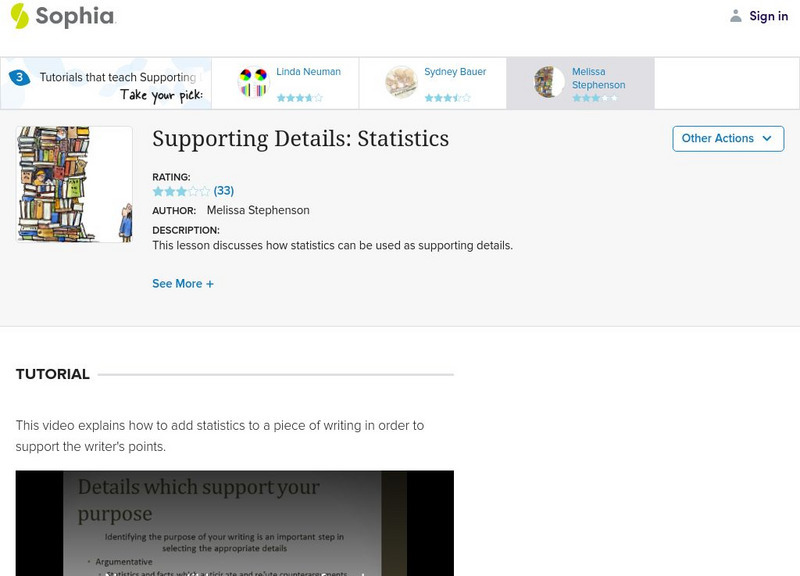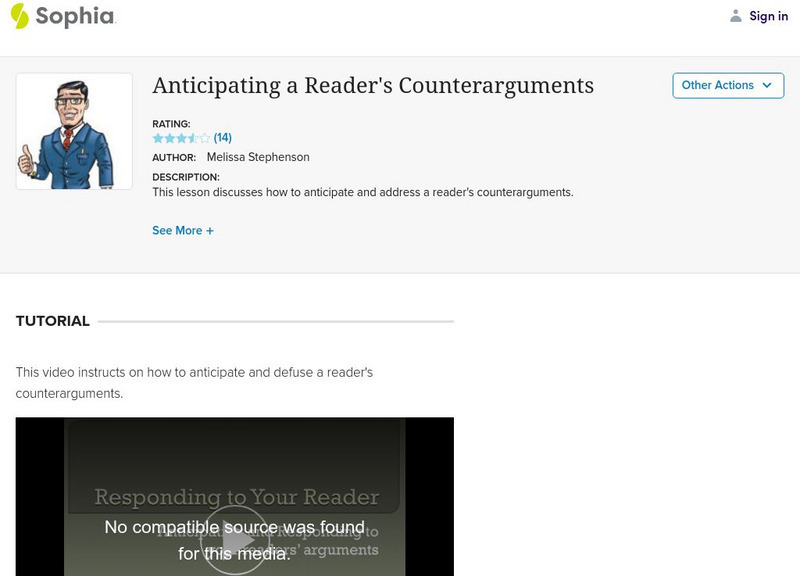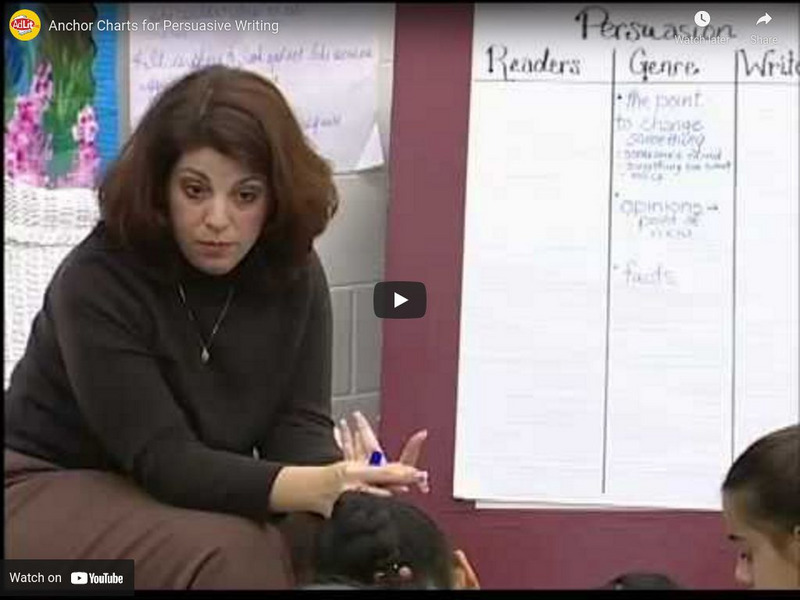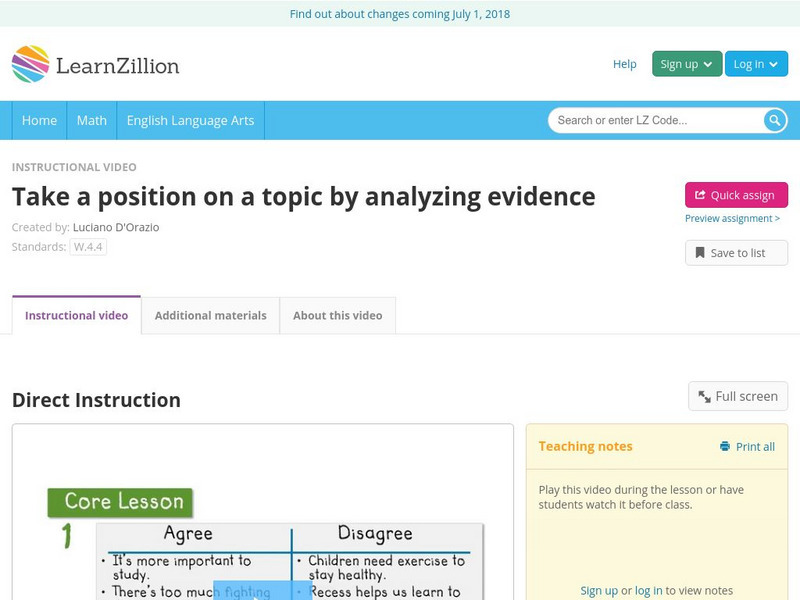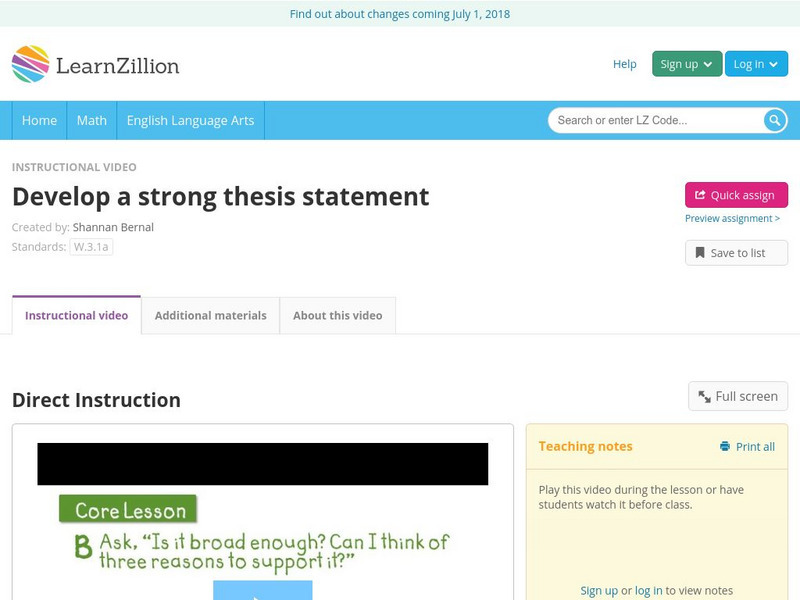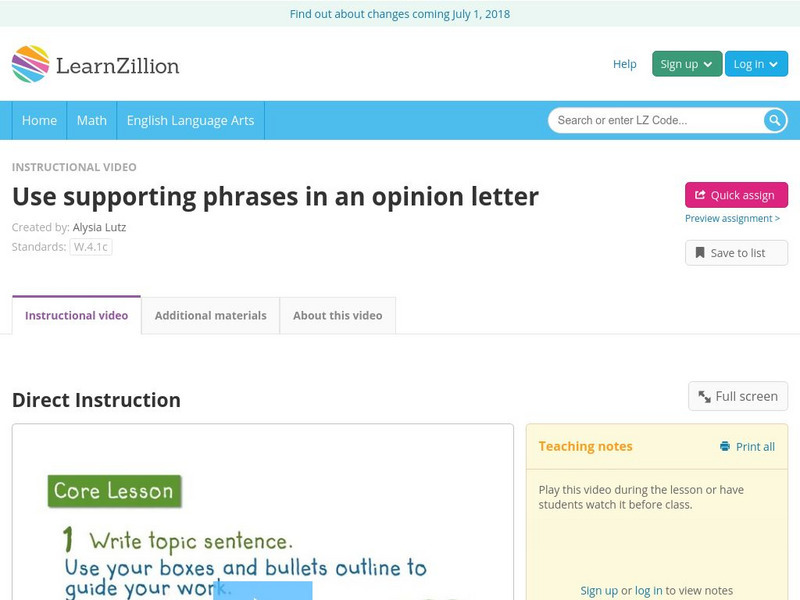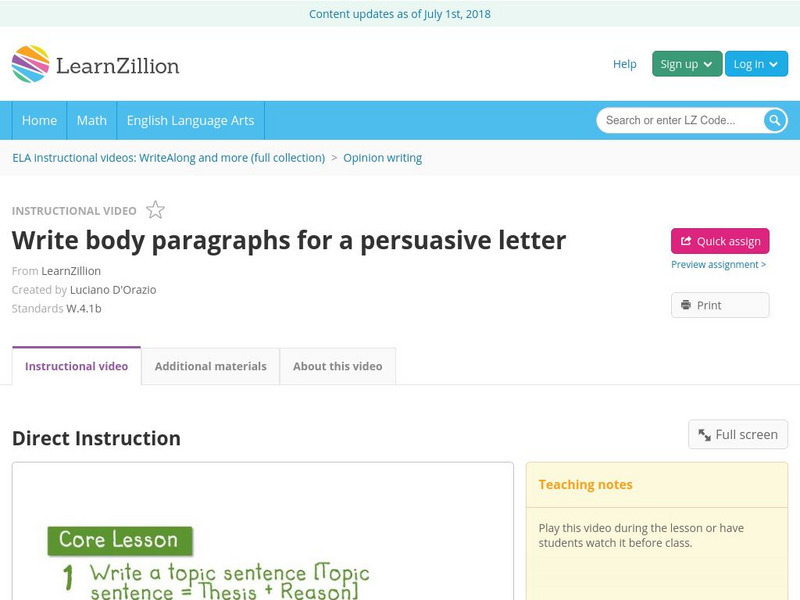Hi, what do you want to do?
Sophia Learning
Sophia: Argumentative Papers
This video lesson focuses on argumentative papers; it begins by defining argument and an argumentative paper including its purpose. It then discusses what is included in an argumentative paper: a thesis statement showing topic and...
Sophia Learning
Sophia: Supporting Details: Statistics
A lesson with audio discussing how analogies can be used as supporting details. [4:00]
Sophia Learning
Sophia: Anticipating a Reader's Counterarguments
A screen cast lesson explaining how to anticipate when a reader might disagree with the author and how, as an author, to address the counterarguments when writing a persuasive/argumentative piece. [6:48] CCSS.ELALiteracy.CCRA.W.1,...
Imagine Learning Classroom
Learn Zillion: Support Your Claim With Reasons and Evidence From the Text
In this lesson, you will learn how to develop your claim by outlining your essay and making sure each reason has sufficient evidence. [6:27]
Imagine Learning Classroom
Learn Zillion: Develop a Claim
In this lesson, you will learn how to generate a precise claim by analyzing your text and notes for reasons and evidence. [7:29]
Imagine Learning Classroom
Learn Zillion: Revise Anecdotes in a Persuasive Essay
In this lesson, you will learn how to make sure your anecdotes are focused on the prompt by using the prompt as you review your work. [5:38]
Imagine Learning Classroom
Learn Zillion: Draft an Introduction to an Argumentative Essay
In this lesson, you will learn how to introduce an argumentative essay by summarizing the text and linking it to your claim and reasons. [5:19]
Imagine Learning Classroom
Learn Zillion: Write Body Paragraphs for a Persuasive Letter
In this lesson, you will learn how to you write body paragraphs by stating your reason and then supporting it with evidence. [5:40]
Imagine Learning Classroom
Learn Zillion: State Opinons Worth Supporting
Writers state opinions worth supporting. Let's practice adding a purpose to our opinion. [8:43]
Imagine Learning Classroom
Learn Zillion: Writing a Hook Sentence and Introducing a Thesis Statement
In this lesson, you will learn how to begin your response by first hooking the reader and then telling them what you will be arguing. [4:26]
AdLit
Ad lit.org: Anchor Charts for Persuasive Writing
A mini video lesson on using an anchor chart to plan a persuasive writing project. At the end of the lesson the students have developed a powerful plan via a graphic organizer to guide them through their writing task.
Imagine Learning Classroom
Learn Zillion: Take a Position on a Topic by Analyzing Evidence
In this lesson, you will learn how to take a position on a prompt by analyzing the evidence for each side. [5:53]
Imagine Learning Classroom
Learn Zillion: Develop a Strong Thesis Statement
In this lesson, you will learn how to write a strong thesis statement by using "BOS." [5:12]
Imagine Learning Classroom
Learn Zillion: Conclude a Persuasive Essay
In this lesson, you will learn how to conclude your persuasive opinion essay by summarizing your key points and telling your reader to take action. [6:50]
Imagine Learning Classroom
Learn Zillion: Use Supporting Phrases in an Opinion Letter
In this lesson, you will learn how to extend your topic and explain your opinion by using supporting phrases. [4:21]
Imagine Learning Classroom
Learn Zillion: Introduce an Opinion in a Persuasive Letter
In this lesson, you will learn how to clearly introduce a point of view in a persuasive letter by organizing different pieces of information into an introduction. Login gives access to a slideshow as well. [5:19]
Imagine Learning Classroom
Learn Zillion: Draft a Conclusion to a Persuasive Letter
In this lesson, you will learn how to relate the conclusion of a persuasive letter to your opinion by reviewing why your reasons support your opinion and make it convincing. Login gives access to a slideshow as well. [7:15]
Imagine Learning Classroom
Learn Zillion: Generate Reasons to Support Your Opinion
In this lesson, you will learn how to generate reasons to support your point of view by rereading the text to find relevant information. Login gives access to a slideshow as well. [7:45]
Imagine Learning Classroom
Learn Zillion: Identify the Parts of a Persuasive Essay
In this lesson, you will learn how to identify the different parts of an essay by labeling the thesis, topic sentence, supporting details and elaboration. [4:53]
Imagine Learning Classroom
Learn Zillion: Write Body Paragraphs for a Persuasive Letter
In this lesson, you will learn how to write body paragraphs by stating your reason and then supporting it with evidence. [5:05]
Imagine Learning Classroom
Learn Zillion: Write a Thesis Statement for a Persuasive Letter
In this lesson, you will learn how to write a thesis statement by checking to see that the thesis statement is an opinion supported by reasons. [4:45]
Imagine Learning Classroom
Learn Zillion: Focusing on the Prompt by Relating Evidence to the Argument
In this lesson, you will learn how to make sure your writing is focused on the prompt by telling the reader how the evidence proves your point. [5:21]
Imagine Learning Classroom
Learn Zillion: Inform a Specific Audience About an Idea by Writing a Persuasive Letter
In this lesson, you will learn how to tell someone specific about your idea by writing a persuasive letter. [4:18]
Imagine Learning Classroom
Learn Zillion: Brainstorm Topics for a Speech by Considering Life's Obstacles
In this lesson, you will learn how to brainstorm persuasive topics by exploring life obstacles. [4:53]






